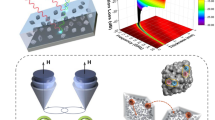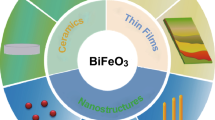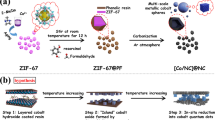Abstract
This work describes the preparation of an organic-inorganic composite and the study of its characteristics. Particles of core (BaTiO3)–shell (SiO2–CoFe2O4) type were used as inorganic composite. These inorganic particles are used for the preparation of composites based on poly(vinyl alcohol) cyanoethyl ether synthesized in an external direct magnetic field. It is determined that the dielectric permittivity of the composites formed in an external magnetic field at the optimal content of the magnetic phase (concentration of CoFe2O4 = 20.3%) is four times as large (ε = 460 at the frequency f = 1000 Hz) as that of analogous composites formed without a magnetic field.






Similar content being viewed by others
REFERENCES
Zhou, D., Electrophoretic deposition of BaTiO3/CoFe2O4 multiferroic composite films, Appl. Surf. Sci., 2011, vol. 257, pp. 7621–7626.
Zheng, H., Multiferroic BaTiO3–CoFe2O4 nanostructures, Science (Washington, DC, U. S.), 2004, vol. 303, no. 5658, pp. 661–663.
Fina, I., Effects of morphology and strain on the dielectric response of multiferroic CoFe2O4–BaTiO3 nanocomposite thin films, J. Appl. Phys., 2010, vol. 108, no. 3.
Zhang, L., Electrical, dielectric and magnetic properties of CoFe2O4–BaTiO3 composite films with core-shell structure, Ferroelectrics, 2009, vol. 406, no. 1, pp. 213–220.
Malar Selvi, M., Magnetodielectric properties of CoFe2O4–BaTiO3 core–shell nanocomposite, J. Magn. Magn. Mater., 2014, vol. 369, pp. 155–161.
Sychov, M.M., Core-shell approach to control acid-base properties of surface dielectric and permittivity of its composites, Chem. Lett., 2015, vol. 44, no. 2, pp. 197–199.
Khamova, T.V., Modification of submicron barium titanate particles via sol-gel synthesis of interface layers of SiO2 for fabrication of polymer-inorganic composites with improved dielectric properties, Russ. J. Gen. Chem., 2013, vol. 83, no. 8, pp. 1594–1595.
Kovalko, N.Yu., Dolgin, A.S., Efimova, L.N., Arsent’ev, M.Yu., and Shilova, O.A., Liquid-phase synthesis and investigation of powders based on zirconium dioxide, Glass Phys. Chem., 2018, vol. 44, no. 6, pp. 626–631.
Maksimov, A.I., Moshnikov, V.A., Tairov, Yu.M., and Shilova, O.A., Osnovy zol’-gel’ tekhnologii nanokompozitov (Principles of Sol-Gel Technology of Nanocomposites), 2nd ed., St. Petersburg: Elmor, 2008.
Zhernovoi, A.I. and D’yachenko, S.V., Measurement of the thermodynamic temperature using a paramagnetic thermometric material, Tech. Phys., 2015, vol. 60, no. 4, pp. 595–599.
Davydov, V.V., Dudkin, V.I., and Karseev, A.Yu., Nuclear-resonance magnetometer with a flowing liquid to measure weak fields, Tech. Phys., 2015, vol. 60, no. 3, pp. 456–460.
Funding
The work was supported by the Russian Science Foundation (project no. 17-13-01382).
Author information
Authors and Affiliations
Corresponding author
Ethics declarations
The authors declare that they have no conflict of interest.
Additional information
Translated by A. Muravev
Rights and permissions
About this article
Cite this article
Sychev, M.M., Shilova, O.A., Matveichikova, P.V. et al. Application of BaTiO3/CoFe2O4–SiO2 Structure to Control the Electrical Properties of Composites. Glass Phys Chem 45, 513–517 (2019). https://doi.org/10.1134/S1087659619060233
Received:
Revised:
Accepted:
Published:
Issue Date:
DOI: https://doi.org/10.1134/S1087659619060233




